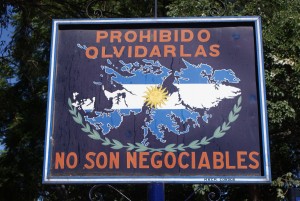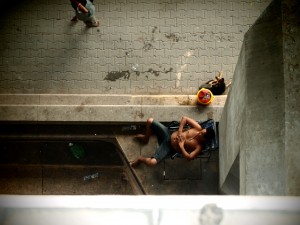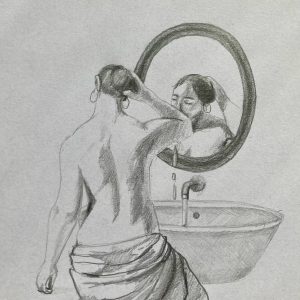
The White Elephant in the Room: Argentina’s “Hidden City”
by William Carter | February 24, 2015
For most, the Argentine Spanish word for slum, ‘villa‘, evokes images of white roofs and white sand. The reality is a labyrinthine network of passageways, carpeted by potholes and framed by drooping electrical wires. There are more dogs than adults and more children than dogs. Men peer menacingly out of barred windows and there are rats in the streets. However there are also shops, restaurants and churches. “Ciudad Oculta”, Hidden City, isn’t an airbrushed postcard of poverty but distinctly Argentine in nature. Drunk men stumble around clutching their mate (the ubiquitous national tea-drink always taken from a s metallic mug with a straw) while sober old ladies sip it in a more refined way from wicker chairs. Horses lumber past pulling carts, a reminder of the importance of the horse in Argentine culture and showcasing how the urban gaucho of today has surrendered vast central plains ranches for the claustrophobia of the villa. However, these contrasts are not clear cut within the slum. There is inequality in that there are perfectly nice houses, randomly dotted around, at odds with their collapsing neighbours. These pockets of proper buildings occur at random, without evidence of forethought or choice over location. There isn’t that glaring, symmetrical inequality that is easy to point to, as in the slums of Rio de Janiero. Houses generally have electricity and water, but these are not always reliable, and there is no air-conditioning – critical in Buenos Aires’ 35-degree Januarys.
Alexander, a 22-year-old construction worker and bodybuilder, moved to to the villa from his native Peru ten years ago. He describes to me the rapid geographical and population growth he has witnessed since first arriving: “The houses were low, their roofs made of metal sheets. Now houses have several stories with proper roofs. But much of this expansion was illegal.” Here the entrepreneurial spirit of the villa works against it in the long run: “There has been much dangerous ‘self-building’ – People build houses with no idea of how to do it – they expand just to have a ‘better’ house – it is libertinism and these houses are ugly and dangerous. Sometimes they fall down. All this contributes to the negative picture of the villas – of us as chorros.”
The idea of a chorro, thief or pickpocket, has become generally synonymous with people, especially men, from the villa. Lili, who works for L.I.F.E, a local NGO, explains that “we try to encourage the children to not dress typically villera, with hoods and caps, to study, to brush their teeth, to not feel proud of being from the villa.” This attempt to ‘normalise’ the villa’s children represents just one of various conflicting roles demanded of them from parents, friends, media and society at large. It’s easy to see why many adopt the identity of the proud villero, or even chorro: it is the one they can most easily embody, or least easily escape. “The police don’t help,” Alex tells me. “I don’t really know why they are here. Maybe to keep the peace, but people still sell drugs in the street, just not quite as openly. If you are young, they treat you like shit because they think that if you’re poor you deserve nothing. They are better with women and older men. Once two guys stole a car, and the police grabbed a friend of mine, who was passing, pepper sprayed him and beat him. My friend went back later to take it up with the police but they beat him up again and took him in. They shoved a gun in his hand and charged him with possession of a firearm.”
The villa was inaugurated in 1937, but residents, along with the government, have only recently begun to take a more nuanced approach to the area’s needs. “They are beginning to introduce social plans to the villas,” Alex tells me, “such as small subsidies for young mothers or people in vulnerable situations. And there are plans for development, like sports, music and art – they teach you how to make jewellery. They are creating urban spaces that we’ve never had in the villas, green spaces – like any other neighbourhood would have.” The government’s contribution is most apparent in the publicly funded comedores, the villa’s idiosyncratic soup kitchens, nothing like the grim Dickensian image with which I was familiar. Although the children who attend are rarely served soup, they are rewarded with milk and cake when they come along to events such as sketching classes or birthday parties every Wednesday put on by local NGOs.
When asked why she works at a comedor, Rosa, a lady of 70 or more flatly responds: “They pay me. My daughter gets free childcare.” Most of her colleagues share her pragmatism and Argentine directness, but they treat the children sympathetically and know their names. And the staff is not just composed of grandmothers: young people too and, perhaps surprisingly in Argentina’s still machista culture, men, young and old, also take shifts. The comedores have been dubbed with evocative names: ‘Las Horas Felices’ (The Happy Hours) and ‘La Unión nos hace fuerza’ (Unity makes us strong) both have an indoor communal area for children to play in. ‘Las Horas’ has good facilities; tables and chairs; whilst in ‘La Unión’ the table football table, 4 pence a go; always draws a good crowd. ‘La Unión’ also seems to be the only soup kitchen in which soup is actually prepared, in the communal space in huge rusty cauldron atop a dirt floor.
Ejército Celestial (Celestial Army) is the least developed site, just a doorway, leading into someone’s living room, with a lady handing out cake on debris-strewn tarmac. It sits in the shadow of the White Elephant, a huge abandoned hospital once intended to be the largest in Latin America, specialising in Tuberculosis. Due to inefficiency and corruption, plans ground to a halt until Domingo Peron’s government restarted work in 1948. Work stopped for good after Perón’s government fell to a military coup in 1955. Now it is put to other use, embodying the messy contrasts of the Hidden City: families rent rooms on the first three floors, cocaine is produced on the higher ones. In its bowels, people of all ages consume Paco, or, technically, freebase cocaine paste, a highly dangerous waste product from the production of coke which is more toxic and addictive than the finished product itself. Police drug raids, sometimes accompanied by with serious police brutality, are a routine sight for the children here.
According to Lili the greatest impediment to progress in the villa and integration of its residents to normal life, isn’t crumbling buildings or stray dogs, but human attitudes towards villeros: “Argentine society is extremely discriminatory. People only have some idea of what it’s like there; they don’t want employees from the villa, even though these people have all the skills needed for the job. The fear they will be robbed, or cheated. They distrust and fear the fact that people from the villas are accustomed to different social codes.” Excluded from mainstream society, unable to rely on its government or police force, the residents of the villa are suspended in an odd middle ground. Discrimination denies them participation in, but they are financially dependent on, mainstream society. Until this imbalance can be righted, the children of the Hidden City will continue to eat, and live, in the shade of the White Elephant.




